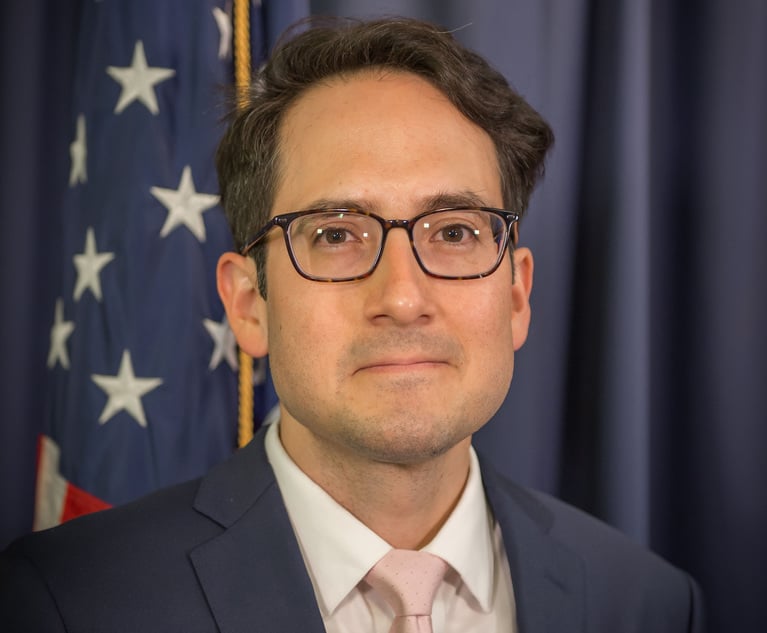IP: ICANN extends objection period
In anticipation of its October meeting in Toronto, the Internet Corporation for Assigned Names and Numbers (ICANN) has been engaged in a flurry of activity related to its New Generic Top-Level Domain (gTLD) Program.
October 29, 2012 at 08:00 PM
6 minute read
The original version of this story was published on Law.com
In anticipation of its October meeting in Toronto, the Internet Corporation for Assigned Names and Numbers (ICANN) has been engaged in a flurry of activity related to its New Generic Top-Level Domain (gTLD) Program. This includes announcing a new proposal for batching applications, a proposed two-month extension of the deadline for filing formal objections, and publishing several draft documents further delineating the rights-protection mechanisms for trademarks in the new gTLD system. ICANN has requested public comments on these proposals, opening the door for a robust dialogue among applicants and interested parties over the course of the next month.
Applicants to Participate In Draw For Priority
On Oct. 10, ICANN posted for public comment its proposal for a new batching process that will “meet root zone scaling requirements and enable timely processing of applications through contract execution and pre-delegation testing.” In contrast to ICANN's previous and very technical “digital archery” batching process, which drew much criticism from gTLD applicants as well as the broader community, the Prioritization Draw is a manual draw through which each participating application receives a “draw number” that determines the order of priority of release of initial evaluation results, which will begin in late March 2013 in weekly batches of approximately 150. All IDN applications will receive first priority in the release of initial evaluation results, in accordance with GAC advice and the “global public interest to provide a broader choice to users in countries that do not use the Latin script.” Applicants will not be permitted to exchange draw numbers, and those that decline to participate will be assigned a randomly generated number at the end of the draw process.
To participate, applicants must purchase a paper ticket in person in Los Angeles on a date (yet to be determined) between Dec. 4 and Dec. 15. ICANN currently estimates the cost of the ticket to be $100. If applicants cannot travel to Los Angeles, they may appoint a representative (or request ICANN appoint one at no cost) to purchase the ticket and participate in the draw. An independent third party (yet to be identified) will conduct the draw.
ICANN has published a more detailed description of the proposed draw, and comments can be submitted. The comment period closes Nov. 9.
Formal Objection Period Extended
In response to numerous public comments, ICANN has proposed to extend the deadline for filing formal objections until March 13, 2013.
The June 4 version of the Applicant Guidebook provides that the formal objections period opens upon the release of the application results and lasts for approximately seven months (Section 1.1.2.2), and also that it closes after the end of the initial evaluation period, within two weeks following the posting of the initial evaluation results (Section 1.1.2.5). Based upon Section 1.1.2.5, and given the various scheduling hurdles in the application process to date, the formal objection period would close sometime in June or July of 2013. Relying on Section 1.1.2.2, however, ICANN announced during an August 9 gTLD applicant webinar that the formal objections period would close January 12, 2013.
Acknowledging that the timing contemplated by the Applicant Guidebook does not account for batching, ICANN now proposes to extend the formal objection deadline an additional two months. This new deadline is included in the Prioritization Draw proposal, which is open for public comment until Nov. 9, 2012. As of October 8, 2012, when ICANN published a program status update in anticipation of its Toronto meeting later this month, no objections had been filed.
Trademark Clearinghouse
ICANN also published for public comment Sept. 25, two explanatory memoranda related to the Trademark Clearinghouse.
The clearinghouse functions as a centralized database of authenticated trademarks to support trademark claims and sunrise services in connection with all new gTLDs. All new gTLD operators will be required to use the clearinghouse to support these rights-protection mechanisms. The clearinghouse must be operated separately, by independent providers. In June, ICANN announced that it had selected Deloitte and IBM from among nine total applicants to be Clearinghouse providers.
The Clearinghouse will not be limited to registered trademarks, but also will include: nationally or regionally registered word marks from all jurisdictions; any word mark validated through a court of law or other judicial proceeding; any word mark protected by a statute or treaty in effect at the time the mark is submitted for inclusion in the clearinghouse; and other marks that constitute intellectual property. The evidence required for inclusion of a trademark in the clearinghouse differs depending upon the category under which the mark is submitted. The clearinghouse will not protect trademark applications, marks still within an opposition period, or registered marks that have been invalidated or cancelled.
During the first 60 days that a new registry is open for general registration (and longer if requested), the clearinghouse will issue two types of notifications if a new domain name registration matches a trademark in the clearinghouse. First, under the trademark claims process, the trademark owner and the registry operator will be alerted to the new filing; and second, the domain name applicant will receive a notification of potential infringement. If the applicant proceeds with registration notwithstanding the notification, the trademark owner may opt to contest the registration through the familiar Uniform Domain Name Dispute Resolution Policy or the new Uniform Rapid Suspension procedure.
The memoranda posted for public comment describe the procedures to be used by Trademark Clearinghouse providers to verify proof of use associated with a trademark in connection with the sunrise process, and the procedures for determining how a “match” between a trademark record and a domain name will be determined for purposes of both the sunrise and claims processes. The memoranda and link for submission of comments are open until Nov. 7.
Although not for public comment, ICANN also published the current draft of the Trademark Clearinghouse Requirements for review. This 75-page document details the responsibilities of the Trademark Clearinghouse providers.
This content has been archived. It is available through our partners, LexisNexis® and Bloomberg Law.
To view this content, please continue to their sites.
Not a Lexis Subscriber?
Subscribe Now
Not a Bloomberg Law Subscriber?
Subscribe Now
NOT FOR REPRINT
© 2025 ALM Global, LLC, All Rights Reserved. Request academic re-use from www.copyright.com. All other uses, submit a request to [email protected]. For more information visit Asset & Logo Licensing.
You Might Like
View All
GOP Now Holds FTC Gavel, but Dems Signal They'll Be a Rowdy Minority
6 minute read


Longtime Purdue GC Accused of Drunken Driving Hires Big-Name Defense Attorney
3 minute readTrending Stories
- 1From Hospital Bed to Legal Insights: Lessons in Life, Law, and Lawyering
- 2‘Diminishing Returns’: Is the Superstar Supreme Court Lawyer Overvalued?
- 3LinkedIn Accused of Sharing LinkedIn Learning Video Data With Meta
- 4Delaware Supreme Court Agrees Insurance Dispute Can Be Retried
- 5New Strategies For Estate, Legacy Planning
Who Got The Work
J. Brugh Lower of Gibbons has entered an appearance for industrial equipment supplier Devco Corporation in a pending trademark infringement lawsuit. The suit, accusing the defendant of selling knock-off Graco products, was filed Dec. 18 in New Jersey District Court by Rivkin Radler on behalf of Graco Inc. and Graco Minnesota. The case, assigned to U.S. District Judge Zahid N. Quraishi, is 3:24-cv-11294, Graco Inc. et al v. Devco Corporation.
Who Got The Work
Rebecca Maller-Stein and Kent A. Yalowitz of Arnold & Porter Kaye Scholer have entered their appearances for Hanaco Venture Capital and its executives, Lior Prosor and David Frankel, in a pending securities lawsuit. The action, filed on Dec. 24 in New York Southern District Court by Zell, Aron & Co. on behalf of Goldeneye Advisors, accuses the defendants of negligently and fraudulently managing the plaintiff's $1 million investment. The case, assigned to U.S. District Judge Vernon S. Broderick, is 1:24-cv-09918, Goldeneye Advisors, LLC v. Hanaco Venture Capital, Ltd. et al.
Who Got The Work
Attorneys from A&O Shearman has stepped in as defense counsel for Toronto-Dominion Bank and other defendants in a pending securities class action. The suit, filed Dec. 11 in New York Southern District Court by Bleichmar Fonti & Auld, accuses the defendants of concealing the bank's 'pervasive' deficiencies in regards to its compliance with the Bank Secrecy Act and the quality of its anti-money laundering controls. The case, assigned to U.S. District Judge Arun Subramanian, is 1:24-cv-09445, Gonzalez v. The Toronto-Dominion Bank et al.
Who Got The Work
Crown Castle International, a Pennsylvania company providing shared communications infrastructure, has turned to Luke D. Wolf of Gordon Rees Scully Mansukhani to fend off a pending breach-of-contract lawsuit. The court action, filed Nov. 25 in Michigan Eastern District Court by Hooper Hathaway PC on behalf of The Town Residences LLC, accuses Crown Castle of failing to transfer approximately $30,000 in utility payments from T-Mobile in breach of a roof-top lease and assignment agreement. The case, assigned to U.S. District Judge Susan K. Declercq, is 2:24-cv-13131, The Town Residences LLC v. T-Mobile US, Inc. et al.
Who Got The Work
Wilfred P. Coronato and Daniel M. Schwartz of McCarter & English have stepped in as defense counsel to Electrolux Home Products Inc. in a pending product liability lawsuit. The court action, filed Nov. 26 in New York Eastern District Court by Poulos Lopiccolo PC and Nagel Rice LLP on behalf of David Stern, alleges that the defendant's refrigerators’ drawers and shelving repeatedly break and fall apart within months after purchase. The case, assigned to U.S. District Judge Joan M. Azrack, is 2:24-cv-08204, Stern v. Electrolux Home Products, Inc.
Featured Firms
Law Offices of Gary Martin Hays & Associates, P.C.
(470) 294-1674
Law Offices of Mark E. Salomone
(857) 444-6468
Smith & Hassler
(713) 739-1250






